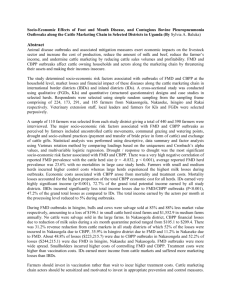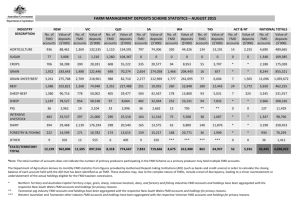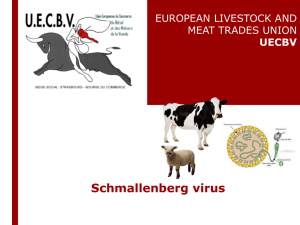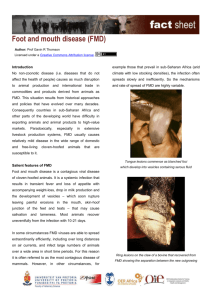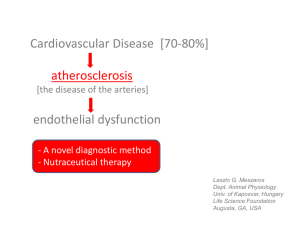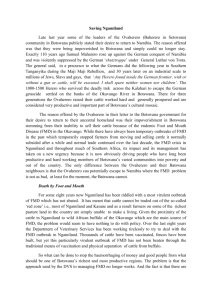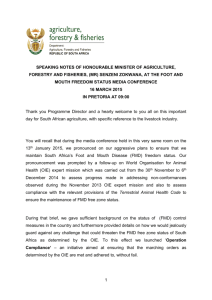Libya - (FMD) - Middle East
advertisement
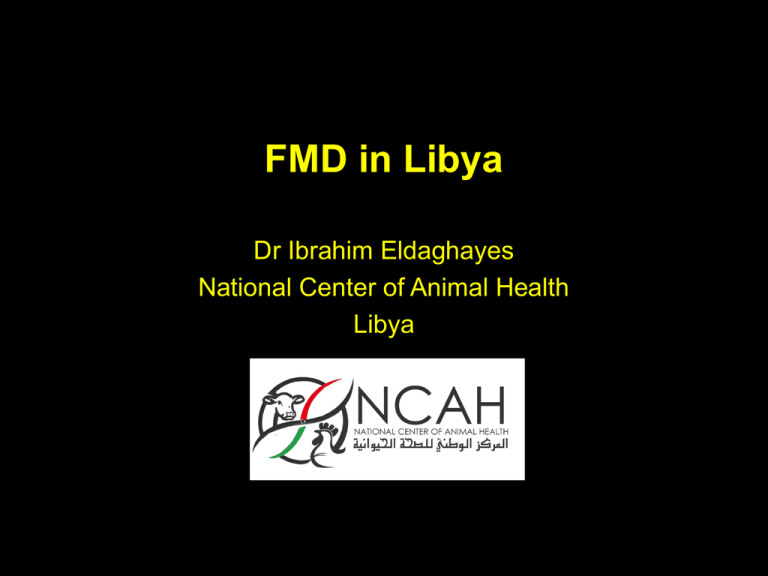
FMD in Libya Dr Ibrahim Eldaghayes National Center of Animal Health Libya History of FMD in Libya: Source: http://www.wrlfmd.org/ Serotype Years FMDV-O: 1959, 1962, 1967-1968, 1972, 1981-1983, 1988-1989, 1994, 2010-2012 FMDV-A: 1979, 2009 FMDV-C: 0000 FMDV-Asia 1: 0000 FMDV-SAT 1: 0000 FMDV-SAT 2: 2003, 2012 FMDV-SAT 3: 0000 Infected herds over consecutive time periods in Eastern area of Libya 28/1 – 31/3/2012 Daily infected herd(s) Last Vaccination Campaign in Libya • We have carried out a mass vaccination campaign that is based on a single injection of FMD vaccine • The campaign started in November 2013. Sheep: A & O, Cattle: A, O • Merial Vaccine • Strains: O Manisa – O 3039 ; A Iran 05 • • • • Killed and purified vaccine 250 Vaccination Teams Once per year Will be twice for cattle this year Meeting in Tripoli, 3rd May 2012, between the Libyan government and IZSLER, Italy – Component 1 will address investigations in FMD suspected outbreaks. – Component 2 will focus on the immune response of vaccinated animals. – Component 3 will focus on serology as a mean to investigate on the level of FMD virus circulation (antiNSP antibodies) and on the serotypes present (antiSP serotype-specific antibodies). Component 1 (FMD suspected outbreaks – Clinical cases) COMPONENT 2 (immune response in vaccinated animals) • This component will address the immune response of vaccinated animals. • The outcome to be measured will be the level of antibodies before the vaccine is injected and the level of antibodies after 30 days from the date of vaccination. • Animals (120 cattle, 150 sheep and 60 goats). • The animals selected for sampling were ear-tagged and blood samples were collected at the day of vaccination and repeated after 30 days. COMPONENT 3 (serologic survey in Large and Small Ruminants) • CATTLE: For cattle a random selection of 300 owners for each of the Western and Eastern region have been carried out and a maximum of 10 animals from each farm belonging to age-category 6-18 months have been sampled. • The outcome to be measured will be initially the level of NSP antibodies as indicator of past or current FMDV infection. Subsequently SP antibodies will also be tested in all or in selected subsets of samples with the attempt to gather information on FMDV serotypes potentially circulating. • SMALL RUMINANTS: The criteria for being enrolled in the study is to owners who have more than 100 individual heads in their flock. • Out of the total number of animals a sample of 48 blood samples have been collected divided into the following age-categories: • (i) 16 samples from the 6-12 months age group • (ii) 16 from animals between 1 and 2 years of age • (iii) 16 from animals with more than 2 years of age. Sera samples collected for the FMD Seroprevalence from the 7 branches • • • • • • • No. 1: Small Ruminants 36 herds = 1728 samples, Cattle: 259 herds No. 2: Small Ruminants 30 herds = 1440 samples, Cattle: 72 herds No. 3: Small Ruminants 15 herds = 720 samples, Cattle: 4 herds No. 4: Small Ruminants 18 herds = 864 samples, Cattle: 111 herds No. 5: Small Ruminants 22 herds = 1056 samples, Cattle: 111 herds No. 6: Small Ruminants 20 herds = 960 samples, Cattle: 37 herds No. 7: Small Ruminants 6 herds = 288 samples, Cattle: 6 herds No. 4 No. 1 No. 5 No. 6 No. 3 No. 2 No. 7 So far: • More than 5000 sera samples have been sent to IZSLER lab in Brescia. • 4 Libyan vets visited IZSLER lab in Brescia (2 weeks); for training and doing the ELISA tests under supervision of IZSLER experts. • Now FMD can be diagnosed in Libya using IZSLER ELISA kits and RT-PCR. Is there anything we could do with our collected sera samples? • Other diseases surveys: – BT – PPR – Brucella – RVF – BVD 2013-2014 FMD Strategy (FMD – Clinical cases) • Component 1: FMD suspected outbreaks • Component 2: immune response of vaccinated animals. • Component 3: Survey to investigate on the level of FMD virus circulation (anti-NSP antibodies) and on the serotypes present (anti-SP serotype-specific antibodies). Component 2 • Collection of serum from unvaccinated animals at the time of injection of the vaccine (time 0) and tag the animals from which the sample has been collected. • Collect after 60,120 and 180 days. • Collect around 100 serum samples from small ruminants from a group of animals with age 6-12 months and other 100 serum samples from small ruminants older than 12 months • For cattle: same age category (two groups: 6-12 months and older than 12 months), also four collection times. Total of animals would be 60 heads. Component 3 • For this component it was agreed that 10 samples will be collected from 30 cities or villages from each NCAH branch (i.e 300 sera samples will be collected from each branch). • 7 branches for the NCAH = a total of 2100 sera samples should be collected from the whole country. • This survey should start after 2-4 months postvaccination and should targeted animals of age 12-24 months old. • Samples were collected and sent to Tripoli and IZSLER lab in Brescia: Positive for serotype O. • Results\Results of suspected samples - Sep 2013 • Results\Results of suspected samples – Nov. 2013 • Detection and Serotyping • New Strain : O/ME-SA/Ind2001 • Genotyping • Vaccine Matching The Progressive Control Pathway for FMD control Progressive Control Pathway (PCP) and Risk Based Strategic Plan implementation: Component 2.3 of EuFMD workplan (REMESA): Assist national FMD risk management as part of the Remesa action plan. Activity in Libya within the component: Training using PEPc to assist national staff to complete RBSP - Support field FMD outbreak investigation Week Date Week 1 26-30/01/2014 Week 2 23-27/03/2014 Week 3 01-05/06/2014 Week 4 22-26/06/2014 • This mission has focused on the training of using PEPc to assist national veterinary staff to complete the Risk-Based Strategic Plan (RBSP). • The main targets of the workshop were: • to make the veterinary services familiar with the principles of PCP-FMD framework • to understand livestock production and FMD occurrence in the country • to identify key risks and important gaps regarding FMD control • to agree on activities that are required to further develop the RBSP. EU-FMD Real-Time Training Course - Lectures 2013 FMD Proficiency Testing Scheme Invitation to LIBYA • PTS 2013 Panel 2 • PTS 2013 Panel 3 • Thanks to: – IZSLER in Brescia – EU-FMD – OIE and FAO – REMESA – Pirbright lab
